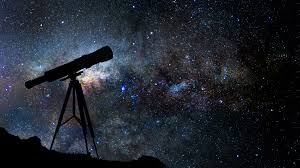A telescope is an optical instrument designed for observing distant objects by collecting and magnifying light.
A telescope is an optical instrument designed for observing distant objects by collecting and magnifying light. Telescopes have been used for centuries to explore the heavens and study celestial objects, but they are also widely employed for terrestrial observations, such as birdwatching and surveillance. Here is a general description of a telescope and its key components:
Optical Tube Assembly (OTA): The main body of a telescope is called the optical tube assembly. It contains the primary optical components that gather and focus light. There are two primary types of telescopes based on their OTA design:
Refractor Telescope: Uses lenses to bend and focus light. The primary lens is called the objective lens.
Reflector Telescope: Uses mirrors to gather and focus light. The primary mirror is called the objective mirror.
Mount: Telescopes are typically mounted on a stable platform or mount that allows for precise aiming and tracking of celestial objects. There are two main types of telescope mounts:
Altazimuth Mount: Allows movement in vertical (altitude) and horizontal (azimuth) directions. It's simpler but less suited for tracking celestial objects as they move across the sky.
Equatorial Mount: Aligned with the Earth's axis, which makes it easier to track celestial objects as they appear to move in an arc across the sky.
Eyepiece: The eyepiece is inserted into the telescope's focusing system and is used to magnify the image formed by the objective lens or mirror. Telescopes often come with multiple eyepieces of varying magnifications to observe different objects and details.
Finder Scope: A smaller, lower-magnification telescope or scope attached to the main telescope. It helps locate and center objects before viewing through the main telescope.
Focuser: The focuser is a mechanism that allows the user to adjust the distance between the eyepiece and the objective lens or mirror to achieve proper focus.
Diagonal: A diagonal is an accessory that allows the observer to view objects at a more comfortable angle, often at 90 degrees from the optical path. It's particularly useful for telescopes that are mounted at awkward angles.
Tripod or Pier: Provides support for the mount and the telescope, ensuring stability during observations.
Filters: Filters can be added to the eyepiece or placed in the optical path to enhance observations of specific wavelengths or to reduce light pollution.
Computerized or GoTo System (optional): Some modern telescopes come with computerized mounts and digital control systems that can automatically locate and track celestial objects based on user input or pre-programmed databases.
Aperture: The diameter of the primary lens or mirror, which determines the telescope's light-gathering ability. Larger apertures can gather more light and provide better image resolution.
Focal Length: The distance from the objective lens or mirror to the focal point where the image is formed. It influences the telescope's magnification.
Collimation: The process of aligning the optical components of a telescope to ensure that the light path is properly focused.
Telescopes come in various designs and sizes, ranging from small, portable models suitable for beginners to large, observatory-grade instruments used by professional astronomers. The choice of telescope depends on the intended use, budget, and desired features for observing both celestial and terrestrial objects.
visit: https://awardandhonors.com/
#Telescope
#TelescopeTuesday
#TelescopeView
#TelescopeTime
#TelescopeObserving
#TelescopeAdventures
#TelescopeSetup
#TelescopePhotography
#TelescopeNights
#TelescopeLife
#TelescopeLove
#TelescopeJourney
#TelescopeEnthusiast
#TelescopeDreams
#TelescopeGoals

Comments
Post a Comment